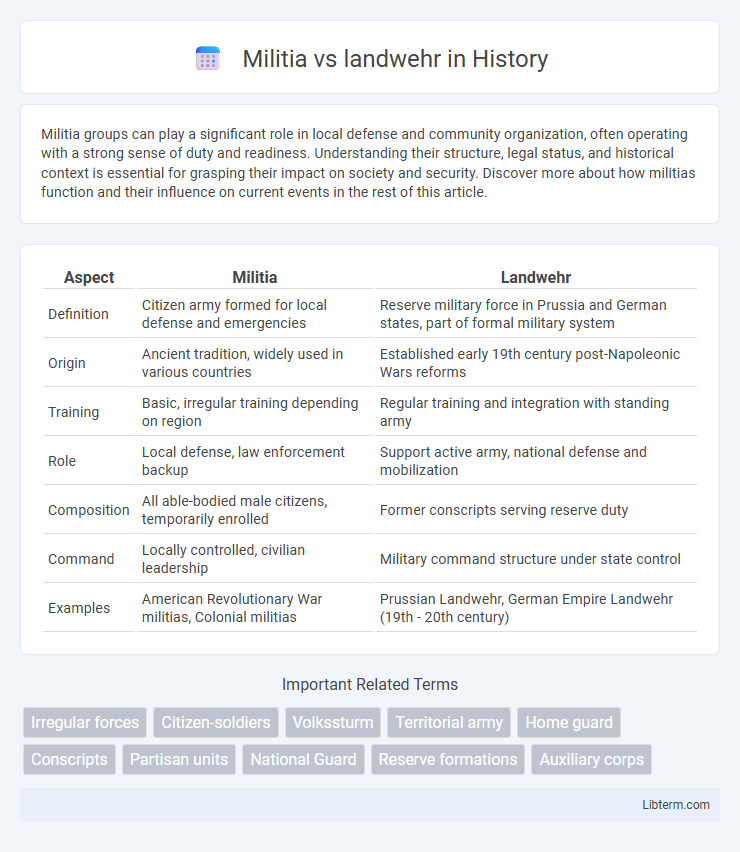Militia groups can play a significant role in local defense and community organization, often operating with a strong sense of duty and readiness. Understanding their structure, legal status, and historical context is essential for grasping their impact on society and security. Discover more about how militias function and their influence on current events in the rest of this article.
Table of Comparison
| Aspect | Militia | Landwehr |
|---|---|---|
| Definition | Citizen army formed for local defense and emergencies | Reserve military force in Prussia and German states, part of formal military system |
| Origin | Ancient tradition, widely used in various countries | Established early 19th century post-Napoleonic Wars reforms |
| Training | Basic, irregular training depending on region | Regular training and integration with standing army |
| Role | Local defense, law enforcement backup | Support active army, national defense and mobilization |
| Composition | All able-bodied male citizens, temporarily enrolled | Former conscripts serving reserve duty |
| Command | Locally controlled, civilian leadership | Military command structure under state control |
| Examples | American Revolutionary War militias, Colonial militias | Prussian Landwehr, German Empire Landwehr (19th - 20th century) |
Introduction to Militia and Landwehr
Militia refers to a military force composed of ordinary citizens trained to provide defense, distinct from professional soldiers. Landwehr is a reserve force in German-speaking countries, primarily made up of trained veterans and older men who supplement the regular army during wartime. Both forces played crucial roles in national defense by mobilizing civilian populations and maintaining military readiness outside of standing armies.
Historical Origins of Militias
Militias have historical origins dating back to ancient times, evolving as locally organized civilian forces for community defense, predating formal standing armies. The Landwehr, emerging prominently in 19th-century Prussia during military reforms, represented a structured reserve force drawn from the citizenry to support the regular army. Unlike militias with varied local customs and informal organization, the Landwehr embodied state-controlled and standardized military readiness rooted in national conscription policies.
Emergence and Development of Landwehr
The Landwehr emerged in the early 19th century as a part-time military force designed to supplement the regular army during wartime, contrasting with the primarily local and often less formal militia units. Developed initially in Prussia during the Napoleonic Wars, the Landwehr was organized based on conscription and training standards closer to a national reserve army, emphasizing systematic mobilization and integration into overall military strategy. This development marked a shift from loosely structured militias toward a more disciplined and centrally controlled force, improving readiness and effectiveness in defense and territorial security.
Organizational Structure: Militia vs Landwehr
The Militia typically consists of part-time, local civilian soldiers with minimal formal training, organized into small, flexible units often led by elected officers. In contrast, the Landwehr is a reserve force composed of trained veterans, structured more like a regular army with standardized regiments and clear hierarchical command. While the Militia emphasizes community-based, irregular defense, the Landwehr maintains disciplined organizational frameworks to support national military operations.
Roles and Functions in Warfare
Militia units primarily serve as part-time, local defense forces mobilized during emergencies, focusing on territorial protection, civil order, and support roles rather than sustained frontline combat. Landwehr forces, historically organized as a second-tier reserve army, undertake more structured military functions, often providing reinforcements, garrison duties, and supplementing regular armies in extended campaigns. Both play critical roles in warfare by expanding manpower and enabling flexible defense strategies, but Landwehr typically engage with greater military training and operational integration.
Recruitment and Membership Differences
Militia forces typically recruit civilians who serve temporarily and often have limited military training, focusing on local defense with rapid mobilization. Landwehr units consist of former active soldiers or trained reservists who have completed initial military service and are subject to periodic training and recall obligations. Recruitment for militias is generally more voluntary and less formalized, whereas Landwehr membership is compulsory for certain age groups, ensuring a more experienced and structured military reserve.
Training and Discipline Comparison
Militia forces typically undergo minimal, short-term training focused on basic marksmanship and local defense, resulting in varying levels of discipline and combat readiness. In contrast, Landwehr units receive more structured and consistent training, often involving periodic drills and exercises designed to maintain higher discipline and operational effectiveness. This difference in training intensity directly impacts their proficiency, with Landwehr generally exhibiting superior discipline and battlefield coordination compared to ad hoc militia groups.
Political and Social Significance
Militia systems often represented broader civic participation and reflected local political autonomy, reinforcing social cohesion through shared defense responsibilities. The Landwehr, particularly in 19th-century Prussia, symbolized state-led military organization aimed at national unification and social integration via compulsory service. Both institutions influenced political structures by balancing centralized authority with grassroots involvement, shaping citizen identity and societal order.
Militia and Landwehr in Modern Context
The Militia refers to a military force composed of ordinary citizens trained to provide defense during emergencies without being part of the regular army, emphasizing rapid mobilization and local defense in modern contexts. The Landwehr, historically a reserve force, functions as a structured part-time military reserve that supports the standing army by maintaining readiness and providing reinforcements. In contemporary defense strategies, militias often serve as auxiliary forces for homeland security, while Landwehr units are integrated into formal military frameworks to ensure national defense resilience and operational flexibility.
Key Differences: Militia versus Landwehr
Militia and Landwehr differ primarily in their organization and function; militias are typically civilian-based forces raised on a temporary basis for local defense, whereas Landwehr units consist of trained reservists integrated into a nation's military system for prolonged service. Militia forces often lack formal training and are mobilized rapidly during emergencies, while Landwehr personnel undergo regular military training and serve as a structured reserve force. The Landwehr operates under stricter military discipline and strategic deployment compared to the more flexible and community-focused militia units.
Militia Infographic

 libterm.com
libterm.com